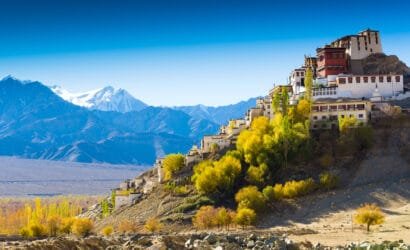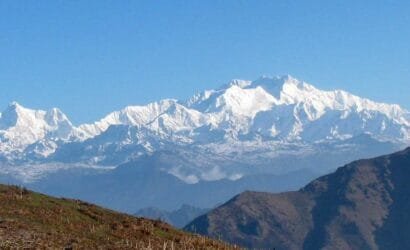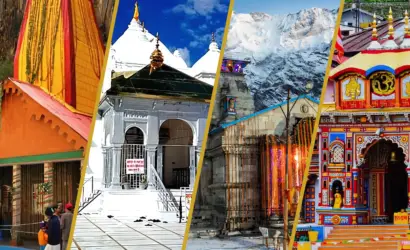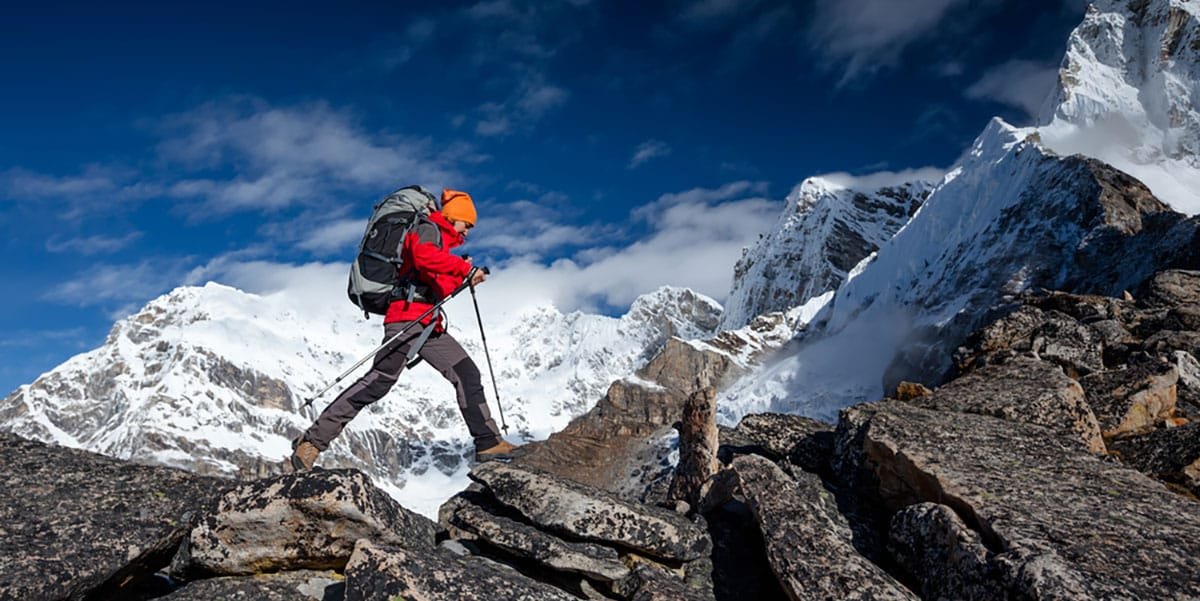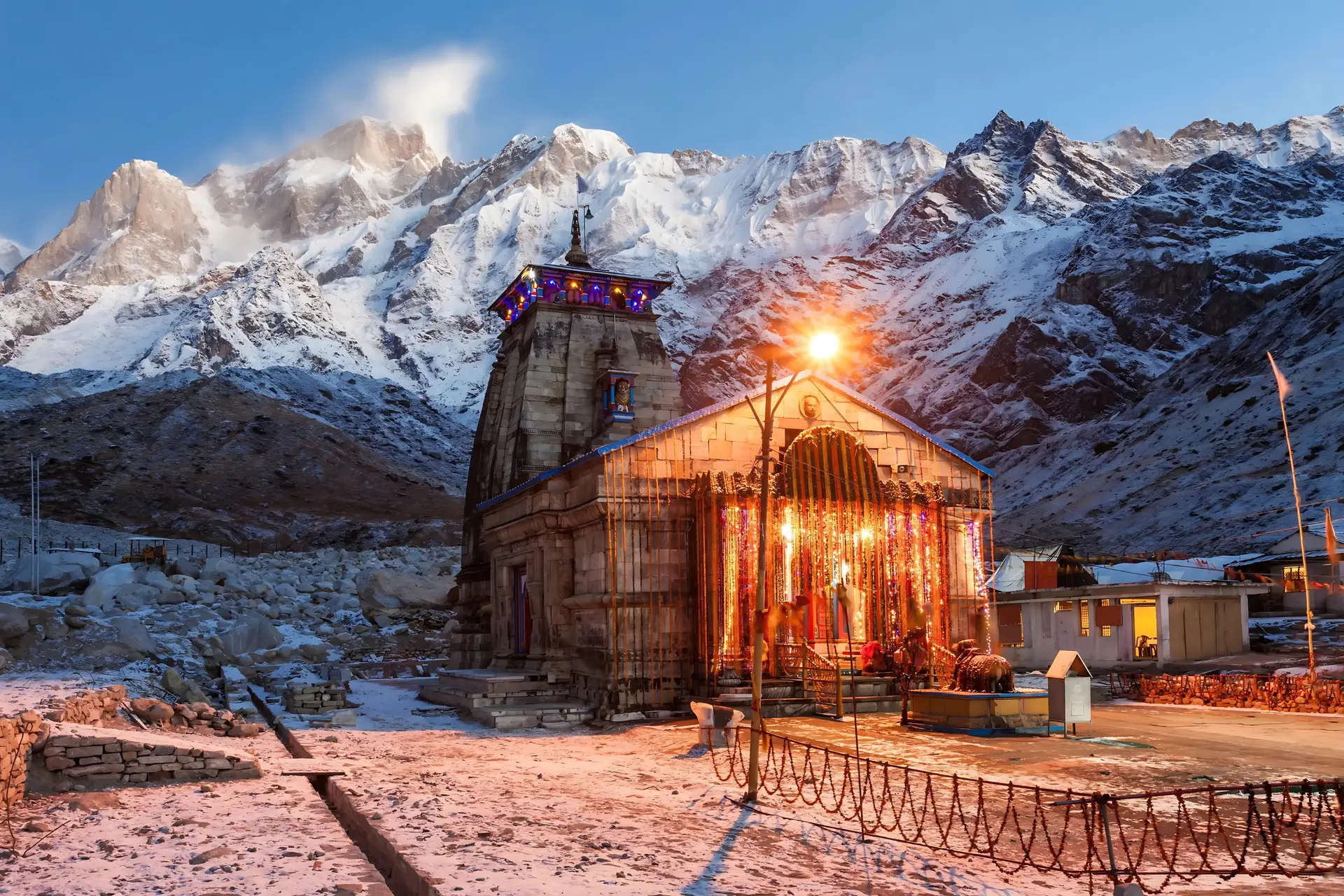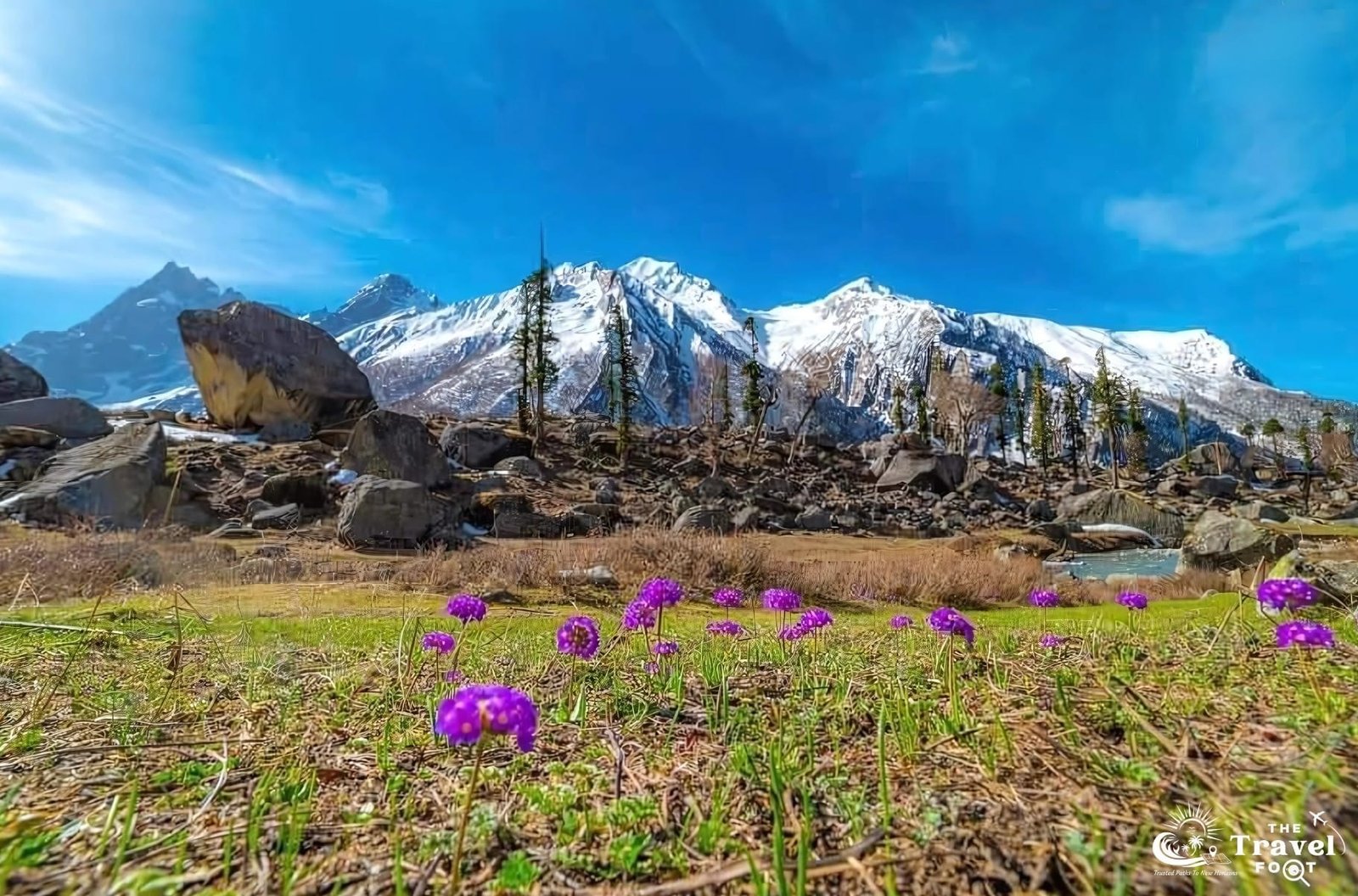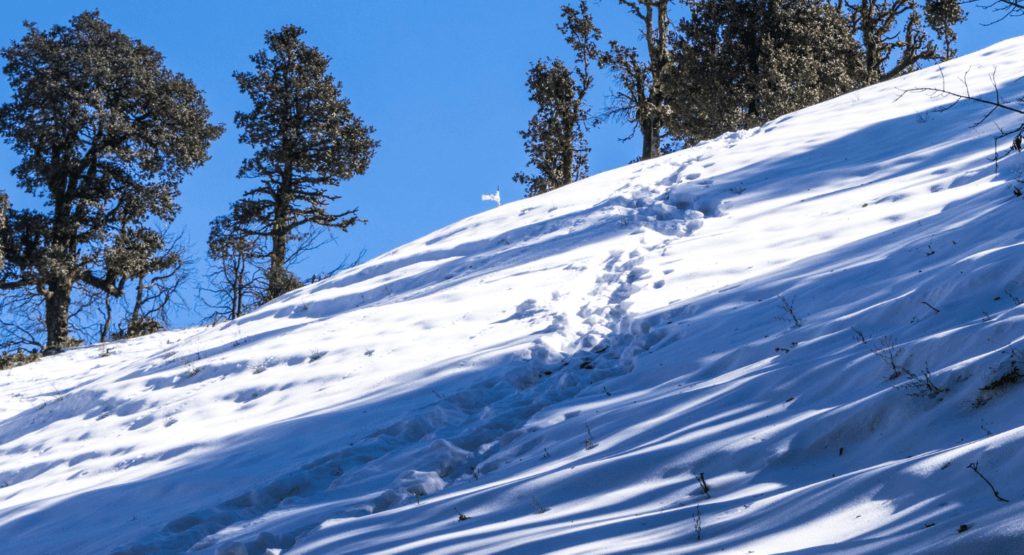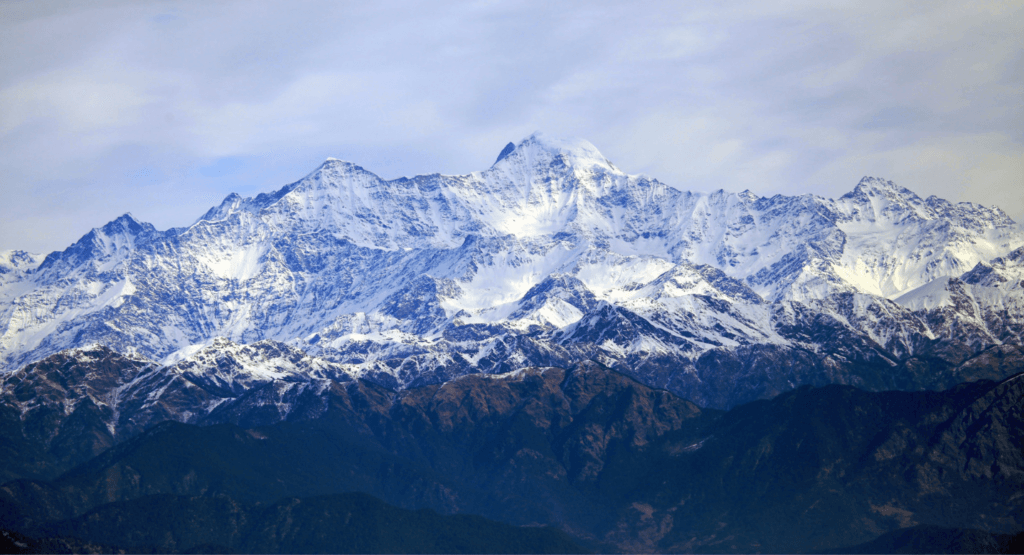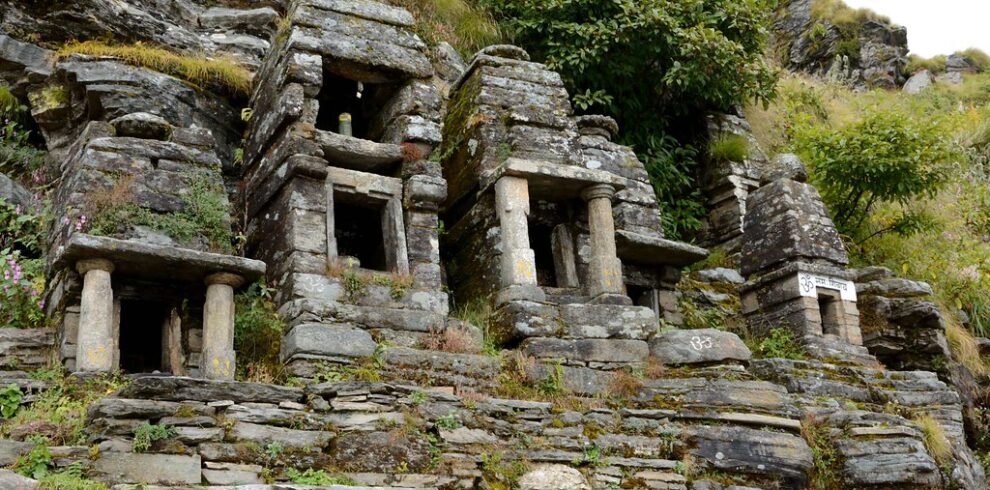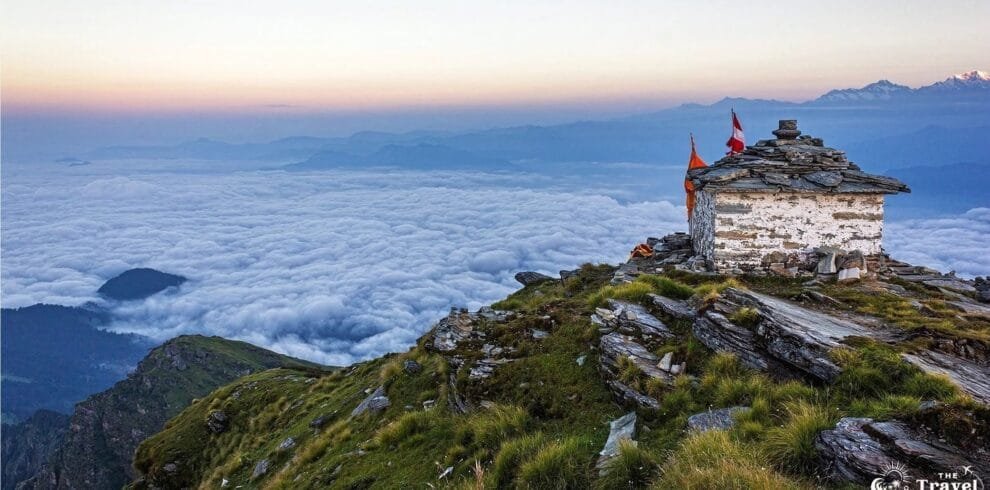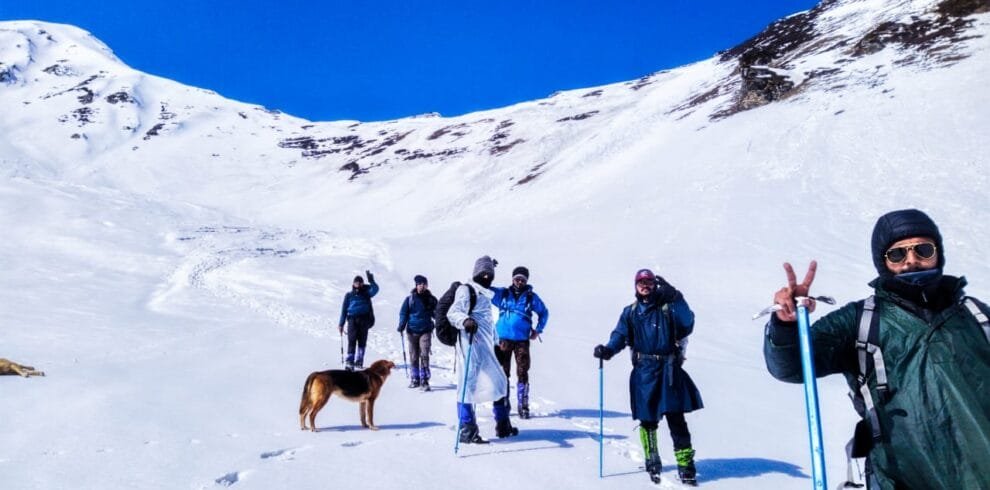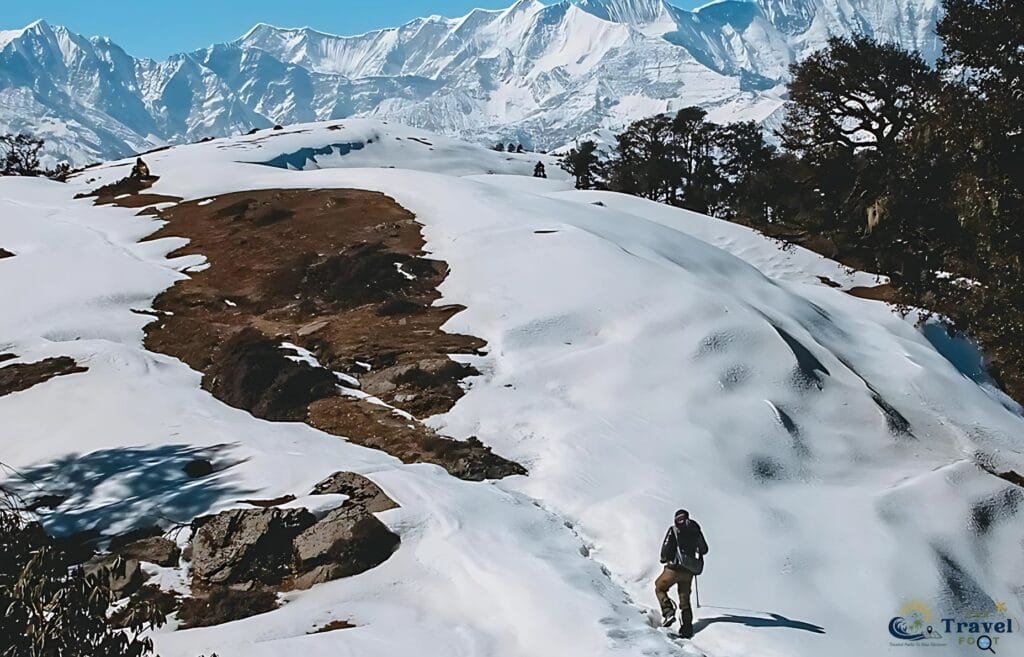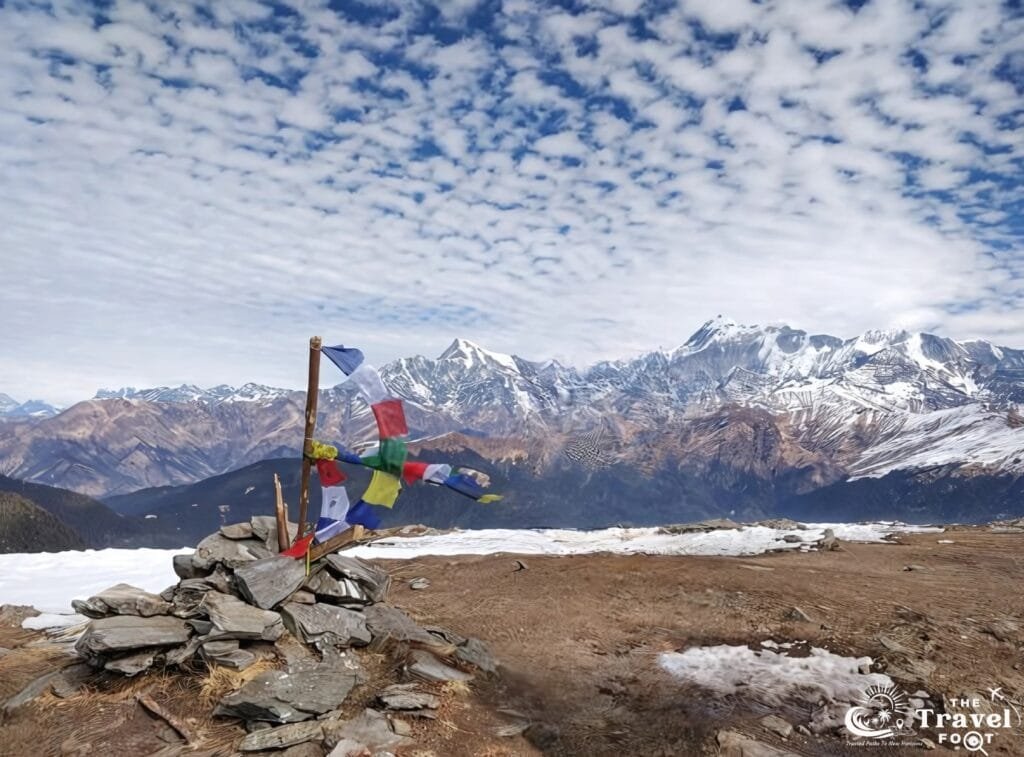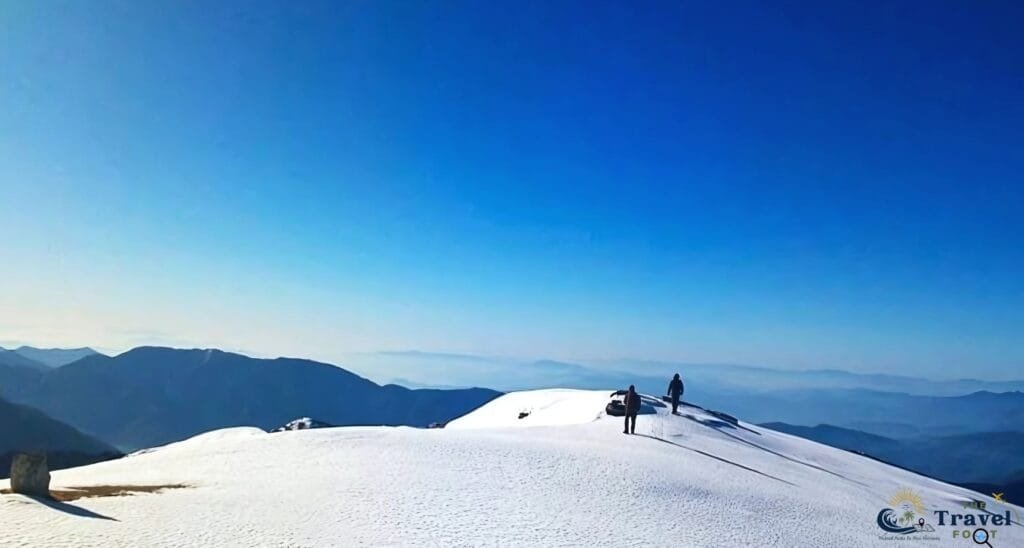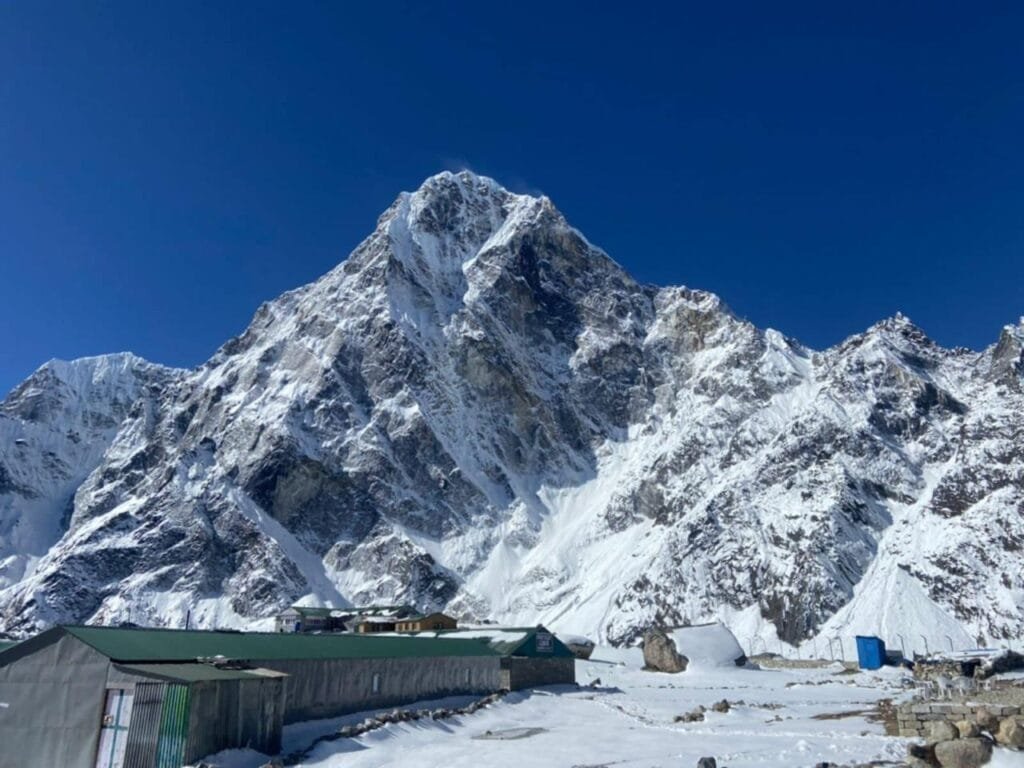
About The Trek
Everest Base Camp Trek is a once-a-lifetime Experience on the renowned Everest Base Camp Trek, a journey that winds through Nepal’s majestic Himalayan terrain. This legendary trek ventures into the heart of the Sagarmatha National Park, a realm of towering giants such as Lhotse, Nuptse, and Ama Dablam. For those who crave adventure and breathtaking vistas, the Everest Base Camp Trek offers an unparalleled experience, combining stunning natural beauty, rich cultural heritage, and a deep sense of accomplishment. The Everest Base Camp Trek provides a traditional experience where hikers can lodge in charming Sherpa villages, gaining insight into their distinct customs, way of life, and strong relationship with the mountains. The trek passes through Namazaar, a lively Sherpa hub, and includes visits to historic Gompas, prayer flags, and stupas showcasing the area. A key attraction is Kala Patthar (5,545m), renowned for its stunning panoramic vistas of Everest and nearby mountains, making it an essential stop for visitors. This iconic trail is deeply rooted in the past, featuring tributes to renowned explorers and pioneers who conquered the mighty Everest in 1953. Further along the path, beyond Dughla, you’ll encounter poignant memorials paying respects to brave adventurers who tragically perished on the unforgiving Himalayan terrain. Embark on a challenging two-week trek that will push your limits but offer breathtaking scenery, deep cultural immersion, and a profound sense of achievement. Whether you are a seasoned or an enthusiastic explorer, the Everest Base Camp Trek promises a once-in-a-lifetime experience, inspiring awe and wonder and combining adventure, cultural discovery, and the beauty of the Himalayas.
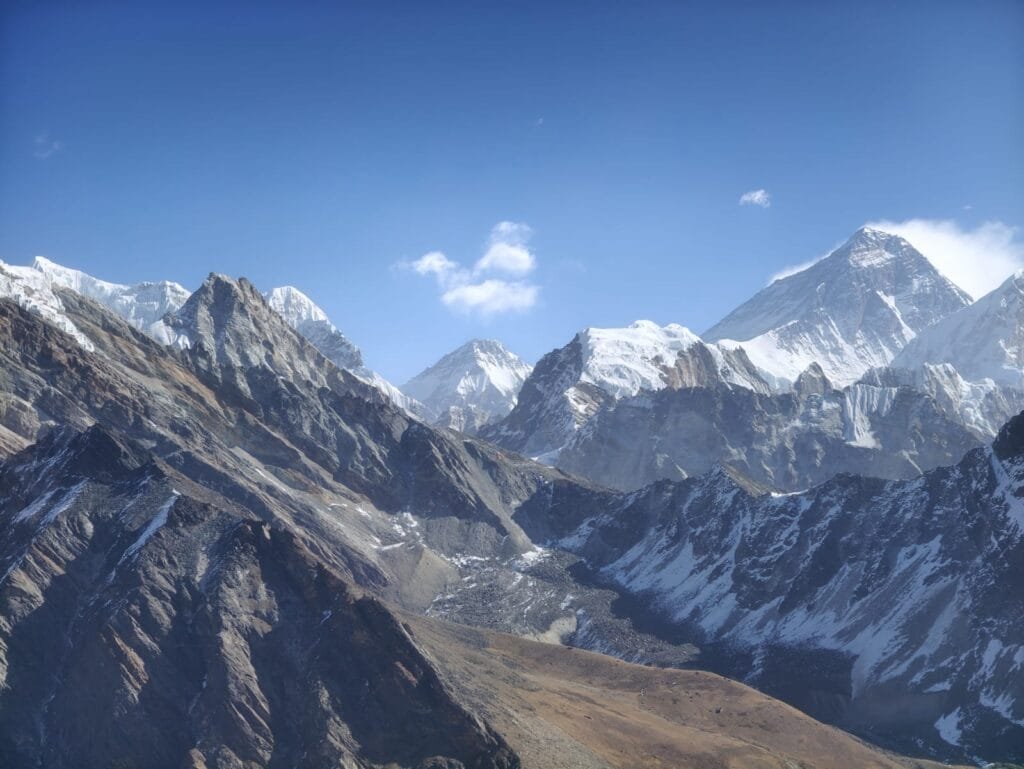
Why Everest Base Camp is a MUST TO DO TREK?
The EBC is an exciting journey that brings you near Mount Everest, providing an unmatched sight of the highest summit on the planet. In addition to Everest, this trek showcases stunning views of three other top peaks globally—Mt. Makalu, Mt. Lhotse, Mt. Cho Oyu, and impressive Himalayan mountains such as Ama Dablam, Nuptse, Kangtega, Pumori, and Thamserku.
Each stage of this remarkable adventure reveals the natural splendour of Nepal’s trekking paths, with majestic snow-covered peaks, deep gorges, and icy rivers around you. As you walk, you’ll encounter authentic Sherpa communities, providing a unique glimpse into their vibrant culture, Buddhist heritage, and mountain way of life. Accommodating yourself in charming teahouses along the way offers a welcoming and genuine taste of Himalayan warmth and hospitality.
The journey to Everest Base Camp is a transformative experience far beyond the final destination. The ascent to high altitudes, surpassing 5,000 meters, is a formidable test of endurance, but the thrill of accomplishment and wonder that awaits at the base camp (5,364m) is genuinely unforgettable. Throughout the trek, breathtaking vistas of towering mountains and crystal-clear glacial elevation points will leave you in a state of constant awe and inspiration.
Embark on an exhilarating adventure that combines heart-pumping excitement with profound cultural and spiritual Traverse lofty suspension bridges spanning turbulent waterways, explore venerable immerse yourself in the mystical aura of the Himalayas. Whether you have nature or cultural immersion, the Everest Base Camp Trek promises an extraordinary odyssey that will forever etch itself in your memory.
Best Time to Commence on Everest Base Camp Trek
March to May and September to November: The best seasons to embark on an Adventure to Everest Base Camp are Spring (March to May) and Autumn (September to November), characterized by favorable weather conditions, crystal-clear skies, and spectacular vistas of the majestic Himalayan peaks.
Note: Meanwhile, the winter months of December to February are marked by serene tranquillity and biting cold. In contrast, the monsoon season, which lasts from June to August, is defined by relentless rainfall, treacherous trails, and reduced visibility.
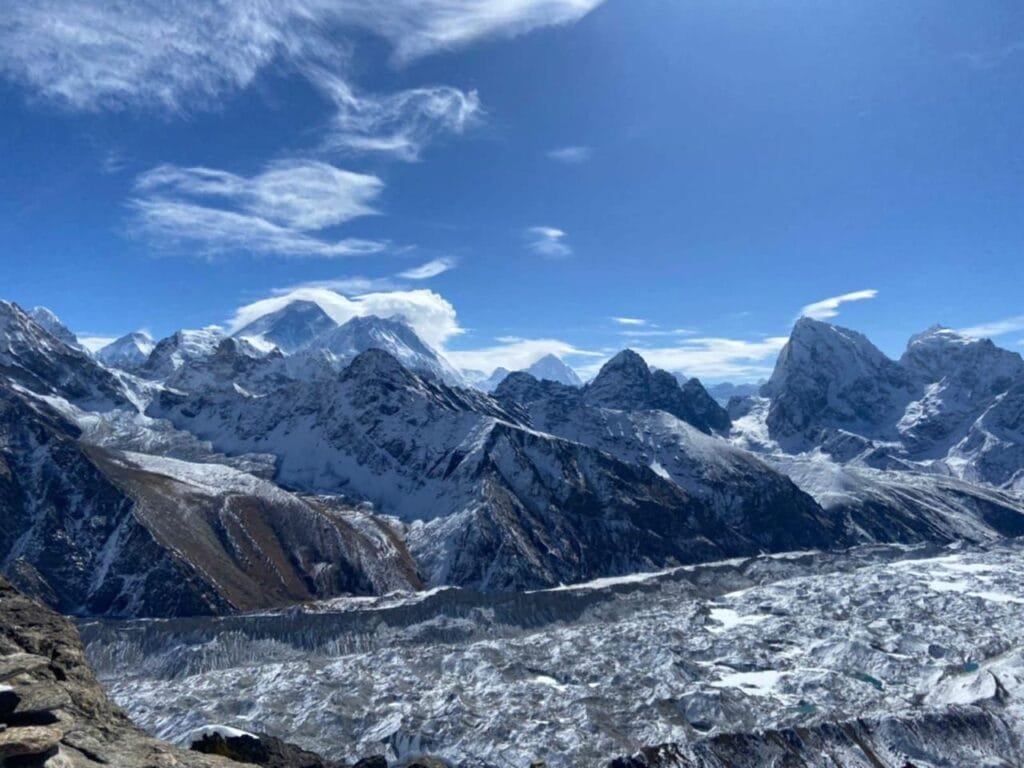
Special Trek Hilights of Everest Base Camp
- Unforgetable Exprience: Commencing on an unforgettable Adventure to Everest Base Camp Trek that seamlessly blends awe-inspiring mountain vistas, immersive cultural experiences, and heart-pumping excitement. Discover the most spectacular features that make this legendary EBC trek unforgettable.
- Summit Top to View Mt. Everest: Kala Patthar, situated at an elevation of 5,545m, is renowned as the top spot for viewing Mount Everest and other majestic peaks such as Lhotse, Nuptse, Pumori, and the Khumbu Glacier. The breathtaking mountain scenery becomes even more enchanting during sunrise and sunset, displaying vibrant alpenglow hues. Being at this vantage point, encircled by the towering Himalayan range, offers a remarkable and fulfilling experience that will stay with you forever.
- Lasting Impression when standing at Base of Mt. Everest: Reaching the Everest Base Camp (EBC) at an altitude of 5,364m is the pinnacle of the Ama Dablam and Kala Patthar. This location serves as the primary staging area for climbers gearing up for their journey to the summit of the Earth's tallest mountain. The pure thrill of standing at the base of Mount Everest leaves a lasting impression.
- Sherpa Settlememt and Culture: Namche Bazaar, nestled at an altitude of 3,440m, is the gateway to Mount Everest. It's a vibrant Sherpa settlement and the main market hub in the Khumbu region. This picturesque town is home to bustling markets, cozy accommodations, and lively cafes, providing trekkers with the perfect setting to acclimatize and explore. The Everest View Hotel offers a breathtaking view of Mount Everest, while the rich Sherpa customs and lifestyle add a unique cultural dimension to your trekking experience.
- Sagarmatha National Park, recognized as a UNESCO Heritage Site, is the highest national park globally. Exploring this park provides a remarkable opportunity to witness the diverse Himalayan ecosystem. Housing unique animals like musk deer, Himalayan tahrs, red pandas, and elusive snow leopards is a haven for those who appreciate nature. Additionally, the park boasts glacial rivers, deep valleys, and lush forests, enhancing the beauty of the trekking experience.
- Witnessing the dawn and dusk in the Himalayas is a breathtaking experience. From the vantage point of Kala Patthar, the initial warmth of the sun's rays on the snow-capped mountains is a sight to behold. As the day comes to a close, the sky transforms into a kaleidos setting sun, casting a warm, golden light over the majestic Everest range, creating an enchanting ambience.
- Commencing on an exhilarating aerial journey from Ramechhap to Lukla, a 25-minute flight that sets the tone for an unforgettable adventure. As you soar through the skies, marvel at the stunning vistas of the Himalayas unfolding below. The landing at Lukla Airport, renowned for its challenging terrain, is an electrifying experience that kick-starts the epic trek to Everest Base Camp.
- On an Unforgettable Adventure: The Everest Base Camp Trek is not just an adventure, it's a transformative journey. It's a blend of thrilling adventure, rich cultural immersion, and breathtaking natural beauty. As you traverse the stunning Himalayan terrain, you'll be warmly welcomed by the Sherpa people, creating memories that will stay with you for a lifetime. This trek is a must-do for adventurers from around the globe, offering a unique opportunity to challenge yourself and discover the beauty of the Himalayas.
Everest Base Camp Itinerary
Travel Sector: Arrival transfer from Kathmandu Airport to Hotel
Transport: For Airport to Hotel Transfer only (group transfer)
Accommodation: 3* Hotel Included
Meals: Dinner on a fixed menu buffet basis
Arrival in Kathmandu Nepal, a country renowned for its majestic Himalayan mountain range, known as the Land of Himalayas. Your adventure commences at Tribhuvan International Airport in Kathmandu, where a convenient transport service is readily available to transfer you to your pre-arranged accommodation in the city center. After you have completed the check-in process, make unwind and rejuvenate. Join a briefing session in the evening to get comprehensive details about your Everest Base Camp Trek. This is a great chance to inquire about the schedule, hiking paths, and necessary equipment. Following your session, you're free to delve into the colorful neighborhoods of Kathmandu, an exciting opportunity to immerse yourself in the local culture, browse the stalls at traditional bazaars, or pick up any remaining gear for our upcoming trek.

Note:
1. Plan to reach Kathmandu airport between 1300-1400 Hrs, so that Group transfer can be arranged from the Airport to the hotel, as 1430 Hrs is a standard time for airport transfer from the airport to the Hotel. Any trekker arriving early to late will have to self-manage the transfer or The Travel Foot will be happy to arrange the same at additional cost.
2. Please note that because of the high air traffic at Tribhuvan International Airport in Kathmandu. Flights bound for Lukla may be rerouted to Ramechhap Airport (Manthali). If your flight is affected, you must leave Kathmandu at 00 AM for a 5-hour road trip to Ramechhap, where you will catch your flight to Lukla the following day. Make sure to rest well tonight in preparation for the early journey ahead.
3. For Indian citizens, you should have a valid Voter Id Card or a Passport, and for other nationals Valid Passport and a Nepal Visa is must.
Travel Sector: Kathmandu - Ramechhap -Lukla-Phakding
Drive Kathmandu to Ramechhap: Approx 135 Kms 4-5 Hrs
Flight to Lukla: 30-45 Minutes
Trek Lukla-Phakding: Approx 7 Kms 4-5 Hrs
Altitude: Kathmandu (4600 Ft.)- Lukla (9350 Ft.) - Phakding (8500 Ft.)
Accommodation: Tea House stay in Phakding
Meals: Lunch and Dinner Only
Transport: Kathmandu Hotel to Ramechhap Airport
Today we will to start early morning and depart Kathmandu at 2:00 AM for a 5-hour drive to Ramechhap Airport (Manthali). From here, you will board an adventurous 30-minute flight to Lukla (2,850 m), one of the most famous high-altitude airstrips in the world. The flight offers breathtaking aerial views of the Himalayan range, marking the beginning of your trekking adventure.
Upon landing in Lukla, you will trek to Phakding (2,600 m). The trail begins with a gentle descent, winding through picturesque Sherpa villages, lush forests, and suspension bridges draped with fluttering prayer flags. The trail is designed with your comfort in mind, featuring gradual ascents and descents, allowing you to soak in the surrounding natural beauty without feeling overwhelmed.
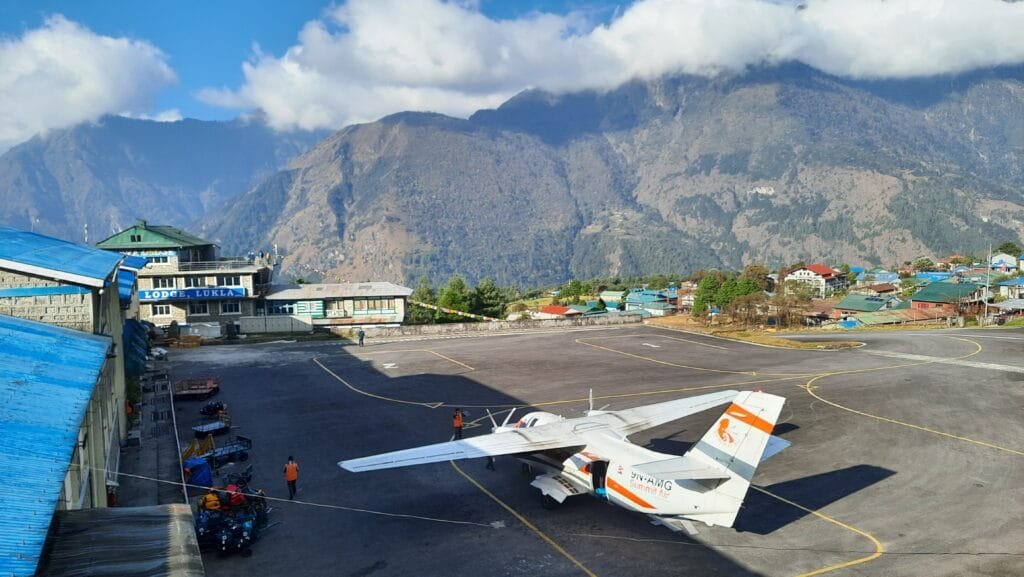
As we continue trekking, you will come across Buddhist prayer stones, mani walls, and chortens, adding a cultural and spiritual element to the journey. Several teahouses along the route, equipped with basic amenities like restrooms and simple meals, allow you to buy or refill your water bottles and take short breaks. Passing through the quaint village of Ghat, you will finally arrive in Phakding, your resting place for the night.
Phakding is an ideal acclimatization stop, helping your body gradually adjust to the altitude before the more challenging trekking days ahead. After reaching your teahouse, you can relax, enjoy a warm meal, and take in the serene and peaceful surroundings of this Himalayan village. Rest well, as tomorrow's trek will take you deeper into the heart of the Everest region.
Travel Sector: Phakding - Namche by Trek
Trek Distance: Approx 10-12 Kms 7-8 Hrs
Altitude: Phakding (8500 Ft.)- Namche 11300 Ft.
Accommodation: Tea House stay in Namche
Meals: Breakfast, Lunch and Dinner Only
After an early breakfast, we begin our trek toward Namche Bazaar, the bustling heart of the Khumbu region. Today's trail offers breathtaking views of verdant hills, cascading rivers, and towering snow-capped peaks, making for an exhilarating journey. Our route is marked by a series of suspension bridges that cross over the Dudh Koshi and Bhote Koshi rivers, some of which are decorated with colourful prayer flags fluttering in the wind. These crossings provide a thrilling experience, offering stunning views of the deep river gorges below.

We set off from Phakding, following the Dudh Koshi River and gradually going through charming Sherpa villages. These villages, with their traditional houses and warm hospitality, are a testament to the resilience and adaptability of the Sherpa people. The initial part of the trek is relatively easy, with short ascents and descents through dense rhododendron and pine forests. As we progress, we reach the second suspension bridge over the Bhote Koshi River, a busy spot where trekkers, porters, and yaks frequently pass through. The bustling atmosphere here is a reminder of how important this trail is for both trekkers and local communities.
A 20-minute uphill climb from this point leads us to Monjo, a picturesque mountain village nestled beneath the towering Thermesarkhu Peak (6,608 m). Monjo is a popular pit stop for many trekkers, and some even camp here. The town is home to fascinating traditional watermills, which locals use to grind barley, a staple crop of the Sherpa people.
Just beyond Monjo lies the entrance to Sagarmatha National Park, a UNESCO World Heritage Site known for its diverse flora and fauna, stunning Himalayan landscapes, and rich cultural heritage. Here, we pause to register our trekking permits, checked by park officials who also maintain records of all trekkers heading toward Everest Base Camp. As we enter the park, we are greeted by spectacular views of Himalayan peaks and the possibility of encountering rare wildlife such as snow leopards, Himalayan tahrs, and red pandas. The trail continues alongside the Dudh Koshi River, winding through thick forests of birch, juniper, and fir trees.
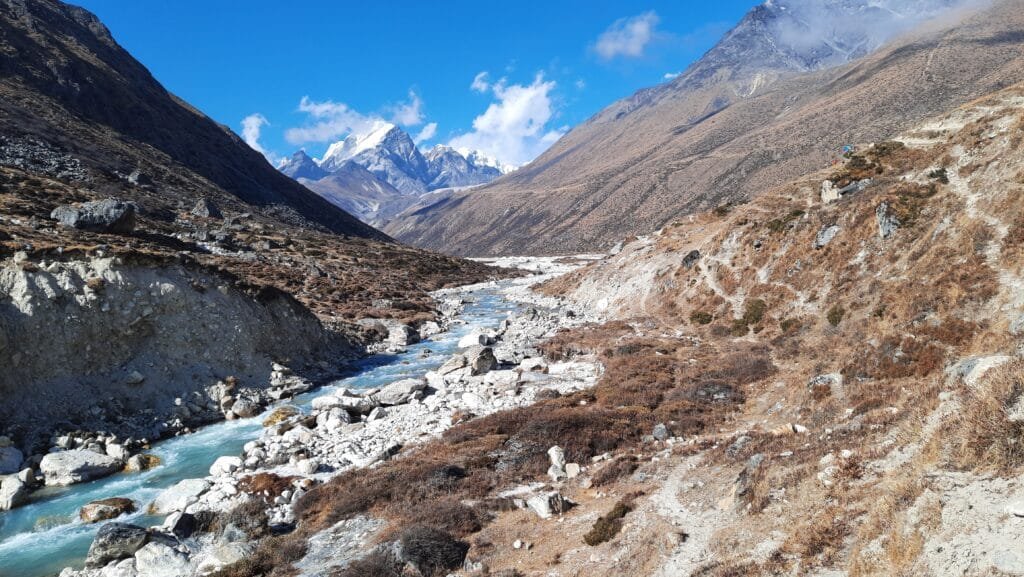
After passing through Jorsalle, the last settlement before Namche, we cross another high-suspension bridge, famously known as the Hillary Suspension Bridge. This bridge is named after Sir Edmund Hillary, the first person to reach the summit of Mount Everest, and it is the highest and longest suspension bridge on the trek, offering awe-inspiring views of the deep river valley below. From here, we begin a steep and demanding ascent toward Namche Bazaar. This climb takes approximately 2-3 hours, with multiple switchbacks testing our endurance. However, the effort is rewarding as we catch our first glimpse of Mt. Everest (8,848.86 m), Lhotse (8,516 m), and Nuptse (7,861 m) on a clear day.
Upon reaching Namche Bazaar (3,440 m), we are welcomed by the lively atmosphere of this historic Sherpa town, often referred to as the 'Gateway to Everest.' Namche is the central trading hub of the Khumbu region, with numerous shops, bakeries, teahouses, and markets. Here, you can indulge in the local cuisine, which includes hearty Sherpa stews, momos (dumplings), and yak cheese. Trekkers can stock up on essentials, purchase trekking gear, or simply unwind in one of the many cosy cafés offering warm beverages and stunning mountain views. The town also houses the Sagarmatha National Park Museum, where you can learn about the Everest region's history, culture, and biodiversity.
After settling into our accommodation, we spend the evening relaxing and eagerly anticipating the acclimatization day tomorrow. This day is crucial, allowing our bodies to adapt to the lower oxygen levels before we continue our trek further into the Himalayas. It's a chance to rest, explore Namche, and prepare ourselves for the challenges and beauty that lie ahead.
After waking up to the awe-inspiring views of the Himalayan peaks, enjoy a hearty breakfast while breathing in the crisp mountain air. Today is dedicated to acclimatization, a crucial process that allows our bodies to gradually adjust to the high-altitude environment before trekking further into the Everest region. Our stay in Namche Bazaar (3,440 m) for the day is not just a rest day, but a strategic move to ensure our bodies are well-prepared for the trek ahead.
Namche Bazaar, the commercial and cultural heart of the Khumbu region, is a vibrant mix of traders, trekkers, and locals. A leisurely stroll through the bustling market, with its array of goods from trekking gear to handmade souvenirs, Tibetan rugs, dried yak meat, and locally crafted handicrafts, is a unique cultural experience. The town's cosy cafés, bakeries, and restaurants add to the charm, making it a perfect place to relax and soak in the unique mountain atmosphere.
For a short acclimatization hike, we will visit the Sagarmatha National Park Headquarters, which provides panoramic views of Everest (8,848.86 m), Ama Dablam (6,812 m), Lhotse (8,516 m), and other surrounding peaks. It's important to remember to walk at a steady pace and take frequent breaks to avoid altitude sickness. Located just above Namche, this vantage point is perfect for capturing stunning photographs. Close to this site is the Sherpa Cultural Museum, where you can learn about the Everest region's history, geography, and biodiversity. The museum also houses historical artefacts, mountaineering gear, photographs of legendary climbers like Tenzing Norgay and Edmund Hillary, and detailed maps of their historic Everest expeditions.

Another short acclimatization walk will take you to the Everest View Hotel (3,880 m), one of the highest-altitude hotels in the world. This is a great spot to enjoy a warm cup of tea or coffee while admiring the majestic views of Everest and other snow-capped peaks. The gradual hike to this location helps improve oxygen flow in your body, making it a recommended activity for altitude adjustment.
As the sun sets, casting a warm glow over the village, you can take a leisurely stroll around Namche Bazaar, immersing yourself in Sherpa culture and Buddhist traditions. The village, with its rich trading history and vibrant marketplace, offers a peaceful and serene end to the day, giving you a glimpse into the traditional lifestyle of the Himalayan people. We return to our guesthouse, for a cozy and comfortable accommodation for a restful evening, ensuring our bodies are well-adjusted before continuing to higher altitudes the next day.
Imp. Note: Acclimatization days like this one in Namche Bazaar are vital in preventing AMS and ensuring a safe and enjoyable trek. By taking these precautions, you increase your chances of successfully reaching Everest Base Camp without health complications.
Travel Sector: Namche - Tengboche by Trek
Trek Distance: Approx 11 Kms 6 Hrs
Altitude: Namche 11300 Ft.- Tengboche (12650 Ft.)
Accommodation: Tea House stay in Tengboche
Meals: Breakfast, Lunch and Dinner Only
Today we wake up to the fresh mountain air and start your day with a delicious and energizing breakfast before beginning today’s trek from Namche Bazaar (3,440 m) to Tengboche (3,860 m). The 11 km trek offers some of the most spectacular views of the Himalayan giants, making it one of the most scenic sections of the Everest Base Camp trail. The journey is moderately challenging, with gradual descents, forested paths, river crossings, and a steep final ascent. Be prepared for varying weather conditions, including possible rain and snow, especially during the steep final ascent.
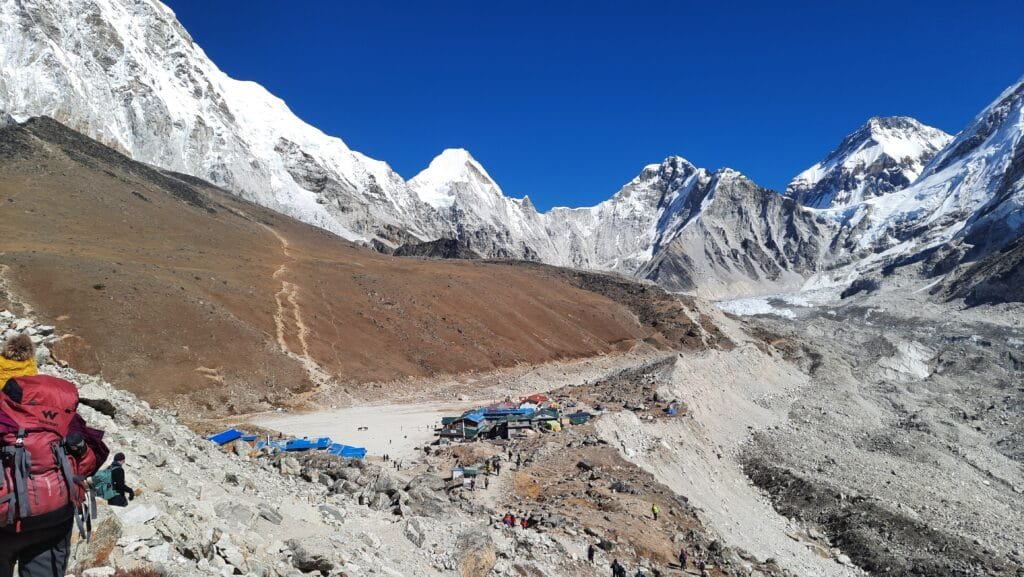
Leaving Namche Bazaar, a 20-minute ascent will bring you to the top of the village, where you'll get a panoramic view of Everest, Lhotse, Nuptse, and Ama Dablam in the distance. As you continue, the trail gradually descends toward Khumjung, a traditional Sherpa village. This is a great place to observe Sherpa culture and lifestyle, and if time permits, you may visit the Khumjung Monastery, which houses what is said to be a yeti scalp! These unique cultural experiences will leave you intrigued and culturally enriched. From here, the trail climbs up stone staircases through rhododendrons and oak forests, leading to the junction at Sanasa. This is one of the last spots where the trail diverges toward Gokyo Valley, but we will continue on the classic Everest Base Camp route.
After a two-hour scenic walk through lush forests, you'll arrive at Phunki Tenga (3,250 m), a small settlement by the Imja Khola River. This is a popular resting point for trekkers, with teahouses serving warm meals and drinks. Along the way, keep your eyes peeled for Himalayan wildlife. This area is home to the Danphe pheasant (Nepal's national bird), musk deer, and the elusive Himalayan Tahr, a mountain goat that resembles an antelope. Birdwatchers will enjoy spotting various species hidden within the dense rhododendron forests.
Crossing a suspension bridge over the river, you'll reach a permit checkpoint, where authorities verify trekking permits before allowing trekkers to continue. This checkpoint is a crucial part of the trek, ensuring the safety and security of all trekkers. The most challenging part of today’s journey begins from here—a strenuous one-hour uphill climb to Tengboche. The ascent follows a series of steep switchbacks, but the effort is well worth it as you catch glimpses of the iconic Tengboche Monastery in the distance. Take it slow and steady, allowing your body to adjust to the increasing altitude.
Finally, you'll reach Tengboche, a beautiful alpine village perched on a ridge at 3,860 meters. This place is famous for the Tengboche Monastery (Dawa Choling Gompa), the Khumbu region's largest and most important Buddhist monastery. Set against the backdrop of Mt. Everest, Ama Dablam, and Thamserku, the monastery offers a truly serene and spiritual experience. If you arrive early, you can witness the evening prayers at 3:30 PM, where monks chant traditional Buddhist mantras in a peaceful atmosphere. The morning prayers at 7:00 AM are also a unique experience for those who wish to immerse themselves in Sherpa Buddhist culture.
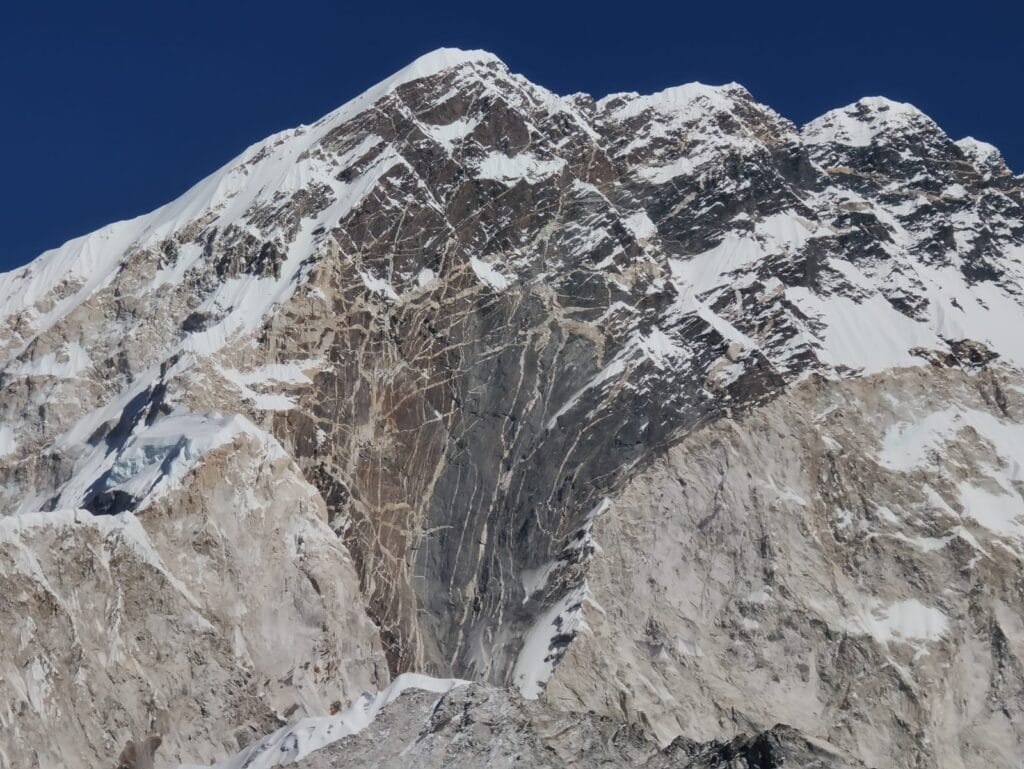
Besides its spiritual significance, Tengboche is a vantage point offering some of the best views of Everest, Nuptse, Lhotse, and Ama Dablam. Spend the rest of the evening soaking in the beauty of the golden sunset over the Himalayas, exploring the monastery grounds, or simply relaxing at your guesthouse with a warm cup of tea. The guesthouses in Tengboche are simple but comfortable, offering basic amenities such as warm beds and hot showers. You will spend the night here at a cosy teahouse, resting for another day of trekking.
Travel Sector: Tengboche to Dingboche by Trek
Trek Distance: Approx 12-13 Kms 7 Hrs
Altitude: Tengboche (12650 Ft.) - Dingboche (14250 Ft.)
Accommodation: Tea House stay in Dingboche
Meals: Breakfast, Lunch and Dinner Only
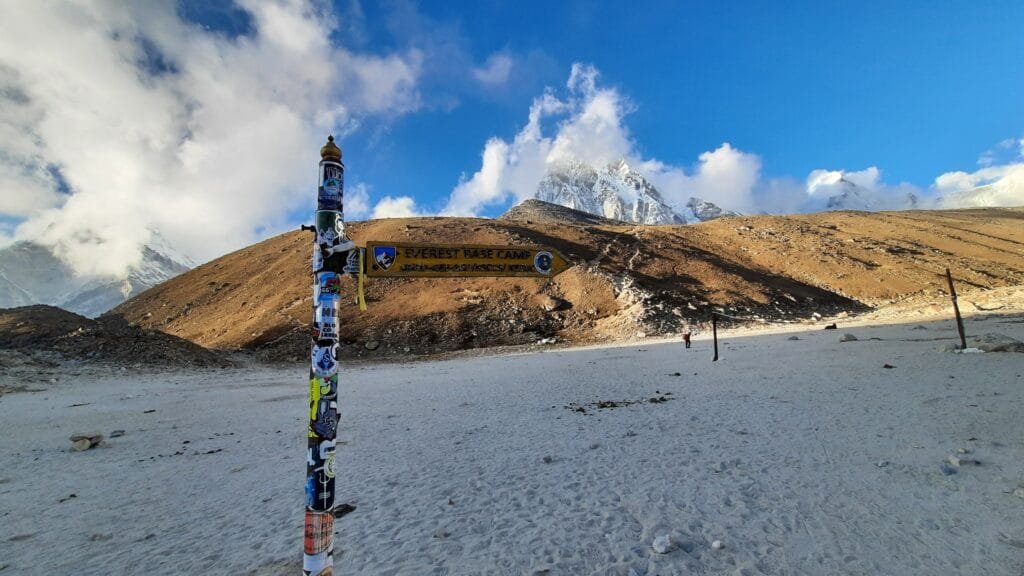
Today we begin the day by rising to the tranquil sounds of chanting monks at Tengboche Monastery, and a warm delicious breakfast amidst the stunning vistas of the Himalayan peaks Lhotse, and Nuptse. Our trek from Tengboche (3,860 m) to Dingboche (4,410 m) is a journey of around 12-13 km that will unfold over 7 hours. The trail promises a varied tapestry of landscapes, shifting from lush forests of rhododendron and conifer to rugged alpine terrain as we ascend. This unique experience of trekking through such diverse landscapes will surely excite the adventurous spirit in you. The trek remains moderately challenging, with gentle inclines rather than steep ascents. As we leave Tengboche, the path descends into a forest, leading to the charming village of Deboche (3,820 m), nestled in a serene valley surrounded by towering trees and exuding mark the trail, guiding us through the dense forests of rhododendron, birch, and conifer. The region is home to a wide variety of Himalayan wildlife, and we may be fortunate enough to catch a glimpse of musk deer, Himalayan Tahr, and pheasants as we make our way through this enchanting landscape. As we proceed, the dense forest gradually recedes, and we traverse a suspension bridge spanning the Imja Khola River. The landscape transforms, with the lush vegetation yielding to rugged, arid terrain, signalling our steady ascent into the high-altitude zone.
We arrive at Pangboche (3,985 m), a picturesque Sherpa village perched at one of the highest permanent settlements in the region. This charming village offers a perfect opportunity to pause for a refreshing tea break, taking in the breathtaking vistas of Ama Dablam. According to local legend, Pangboche is also renowned for its ancient monastery, which is said to have once housed relics of a yeti's scalp and hand. These relics are considered sacred by the Sherpa people, and their presence in the monastery is a testament to the rich cultural heritage of the region. From here, the trail winds upward, passing through several small Buddhist shrines and fluttering prayer flags as we enter the Imja Valley.
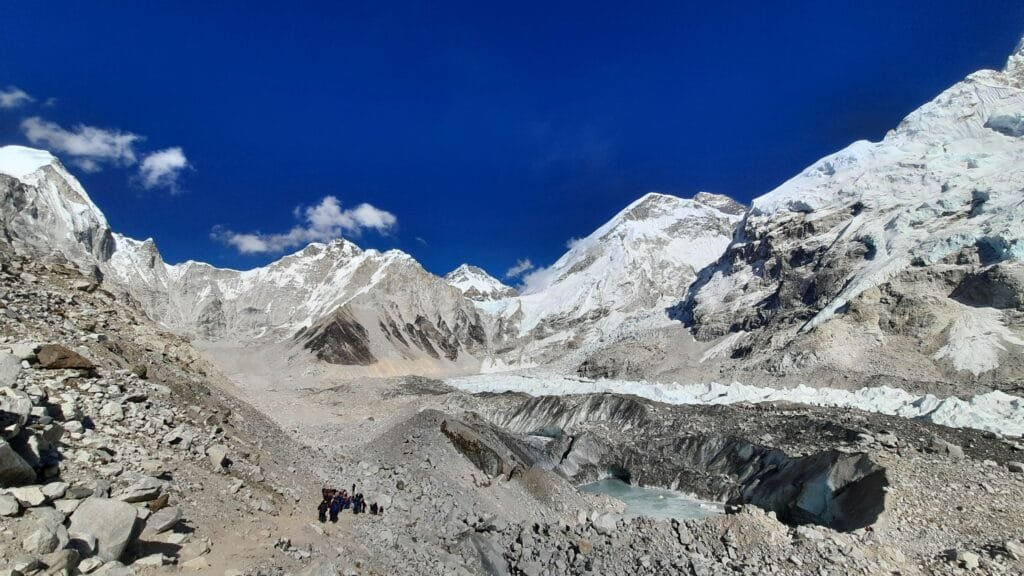
The majestic Lobuche River flows gently through the valley, creating a stunning visual contrast against the towering peaks of Lhotse. Nupt drier and windier as we transition into the alpine zone, where vegetation becomes sparse, with only hardy shrubs and grasses thriving in the harsh conditions. We then reach Shomare, a tiny outpost at 4,010 meters, marking the last significant halt before Dingboche. After a short respite, we press on towards our destination. The scenery transforms strikingly, with Ama Dablam looming large on the horizon from a fresh vantage point. The path then follows the valley's edge, spanning a wooden bridge over a glacial brook, before climbing steeply into Dingboche, situated at 4,410 meters. This charming Himalayan village is characterized by its neatly stone. On arrival check into our tea lodges and rest of the evening for rest and relax.
After days of trekking through the rugged and breathtaking landscapes of the Everest region, today will be dedicated to a crucial aspect of our journey-acclimatization. As we ascend, our bodies must adapt to the thin air and reduced oxygen levels to avoid altitude sickness. Instead of staying idle, we will undertake a short but essential acclimatization hike, allowing our bodies to adjust while enjoying the stunning Himalayan scenery.
Dingboche, often called the "summer valley" of the Khumbu region, sits in a broad valley surrounded by snow-capped peaks. It is one of the last major Sherpa settlements on the Everest Base Camp trek and is known for its stone-walled fields that protect barley, potatoes, and buckwheat crops from the strong Himalayan winds. Unlike other villages at lower altitudes, Dingboche experiences harsher weather conditions, colder temperatures and drier terrain. The views from here are spectacular, featuring Ama Dablam (6,812 m), Lhotse (8,516 m), Island Peak (6,189 m), and Makalu (8,481 m) in the distance.
Acclimatization Hike to Chukhung (4,730 m) – A Glimpse of the High Himalayas
To make the most of our acclimatization day, we will embark on a gradual ascent towards Chukhung, a small village in the Imja Tse Valley. The hike takes approximately 3 to 5 hours round trip, with an altitude gain of about 320 meters. Although the incline is relatively moderate, the effects of altitude become more noticeable, with many trekkers experiencing shortness of breath and fatigue due to the lower oxygen levels.
The trail begins eastward from Dingboche, following the valley floor before ascending through rocky and barren terrain. As we climb higher, the panoramic views of surrounding peaks become even more mesmerizing. Along the way, we will see prayer flags fluttering in the wind, small stone chortens, and yak pastures scattered across the valley.
Chukhung is a remote but picturesque village with many teahouses catering to trekkers and climbers preparing for Island Peak (Imja Tse) expeditions. Upon reaching Chukhung, we will take a break to enjoy the surreal landscape, surrounded by towering glaciers and rugged mountain slopes. The views from Chukhung are among the best in the entire trek, offering a clear sight of Island Peak, Amphu Lapcha Pass, and the massive Lhotse face.
After soaking in the stunning vistas and catching our breath, we will descend back to Dingboche, taking it slow to avoid unnecessary strain on the body. The downhill return is much easier, allowing us to appreciate the vast, open landscapes of the Imja Valley before reaching our guesthouse.
Rest and Explore Dingboche Village
We will spend the rest of the day in Dingboche relaxing, hydrating, and refuelling with warm meals. If you feel energetic, you can walk around the village, visiting the local teahouses, bakeries, and small shops that cater to trekkers. Since Dingboche is one of the last villages before higher-altitude climbs, it's a great place to stock up on last-minute supplies. The evening offers an opportunity to interact with fellow trekkers, Sherpa guides, and locals. These interactions not only provide valuable information about the trek and the region but also create a sense of community, making the trek more enjoyable and memorable.
Why is Acclimatization Crucial?
Acclimatization is key to preventing altitude sickness, which can occur when ascending too quickly. Symptoms include a persistent headache, nausea, dizziness, fatigue, and shortness of breath even at rest. In severe cases, altitude sickness can lead to life-threatening conditions like High Altitude Cerebral Edema (HACE) or High Altitude Pulmonary Edema (HAPE). It's important to be aware of these symptoms and to communicate any discomfort to your guide or fellow trekkers.
To stay safe at high elevations, follow these precautions:
✅ Hydrate well – Drink at least 3-4 litres daily.
✅ Eat nutritious meals – Carbohydrates help maintain energy levels.
✅ Avoid alcohol and smoking – These can exacerbate altitude sickness.
✅ Ascend gradually – Taking acclimatization hikes helps your body adjust.
✅ Listen to your body – If symptoms worsen, descend immediately.
After an insightful and restful day in Dingboche, we will retire early to prepare for the next stretch of our journey. The upcoming days will take us to even higher altitudes, bringing us closer to Everest Base Camp.
Travel Sector: Dingboche to Lobuche by Trek
Trek Distance: Approx 6-7 Kms 7 Hrs
Altitude: Dingboche(14250 Ft.) - Lobuche (16200 Ft.)
Accommodation: Tea House stay in Lobuche
Meals: Breakfast, Lunch and Dinner Only
After an early breakfast in Dingboche (4,410 m), we will begin our challenging trek towards Lobuche (4,940 m), gradually making our way deeper into the heart of the Everest region. Today's trail will take us through alpine pastures, rocky landscapes, and the massive Khumbu Glacier moraine, offering some of the most dramatic views of the towering peaks that define this region. The trek covers a distance of approximately 6-7 km and will take around 6-7 hours, with an elevation gain of 530 meters. Please note that this trek is considered difficult due to the high altitude and the steep ascent.
As we leave Dingboche, we ascend a small ridge behind the village, greeted with a stunning view of Lobuche Peak (6,119 m) and the Cho La Glacier fields. Looking back, we can see the entire Imja Valley, with its small scattered settlements and winding trails. The path continues alongside the mountain wall, gently inclining through the high-altitude pastures where, during summer, we may spot yaks grazing on the sparse vegetation.
Through Pheriche and the Valley Beyond
After trekking for about an hour, we turn along the valley and descend slightly towards Pheriche, a small mountain settlement popular among trekkers and mountaineers. Pheriche also houses a high-altitude clinic run by the Himalayan Rescue Association (HRA), which serves as a medical post for altitude sickness patients. We will pass through Pheriche again on our way back from Everest Base Camp, but for now, we continue onward.
The trail remains relatively moderate for the next two to two and a half hours, following the Dudh Koshi River as we make our way further into the glacial valley. The incline is not very steep, but oxygen levels are significantly lower at this altitude, making it essential to trek slowly and conserve energy.
Reaching Thukla and the Challenging Ascent to Thukla Pass (4,830 m)
As we approach Thukla (4,620 m), we cross a wooden bridge over a glacial stream, with glorious views of the towering peaks in front of us. Thukla is a small settlement with a few teahouses, making it an ideal spot for a short break to rest, hydrate, and refuel with some warm tea or snacks.
The next section of the trek is one of the most challenging parts of today's journey—the steep ascent to Thukla Pass. The trail climbs sharply through a zigzagging path, gaining over 200 meters of elevation over a short distance. The high altitude and thinning air make this climb particularly demanding, but as you conquer it, you'll feel a sense of pride and accomplishment. So, pace yourself, take deep breaths, and take breaks when needed.
At the top of the pass, we arrive at the Everest Memorial Site, a place of profound beauty and solemnity. It's dedicated to climbers and Sherpas who lost their lives attempting to conquer Mount Everest. Among the many stone cairns and plaques, you will see memorials for famous climbers such as Scott Fischer and Rob Hall, who tragically perished during the 1996 Everest disaster. The atmosphere here is humbling and emotional, reminding us of the extreme challenges of high-altitude mountaineering.
Final Trek to Lobuche Alongside the Khumbu Glacier
After taking a moment to pay our respects at the memorial site, we continue our trek, following the left side of the Khumbu Glacier. The landscape here becomes increasingly barren and rugged, with large boulders, icy patches, and scattered glacial debris dominating the scenery.
As we move forward, the air becomes thinner, and temperatures begin to drop noticeably, especially when the wind picks up along the glacier. The trail gradually inclines as we approach Lobuche (4,940 m), a small settlement between towering peaks.
Upon arrival in Lobuche by early afternoon, we will check into our teahouse for the night. Lobuche, a small settlement between towering peaks, serves as an important resting point in our journey. The village is relatively small, with only a handful of lodges, but it offers a stunning panoramic view of Nuptse (7,861 m) right before us. As the sun begins to set over the mountains, the golden hues reflecting off the snow-capped peaks create an unforgettable sight. This rest stop is crucial for acclimatization and to prepare for the next leg of our journey.
After a long and rewarding day, we will enjoy a hot meal in our teahouse, replenish our energy, and rest. Tomorrow, we embark on the most anticipated leg of our journey—Everest Base Camp! The excitement is palpable as we prepare for the next stage of our adventure.
Travel Sector: Lobuche-EVEREST BASE CAMP - Gorak Shep by Trek
Trek Distance: Approx 9-10 Kms 7-8 Hrs
Altitude: Lobuche (16200 Ft.)- EBC (17700 Ft.) - Gorak Shep (16900 ft.)
Accommodation: Tea House stay in Gorak Shep
Meals: Breakfast, Lunch and Dinner Only
Today marks the most anticipated and thrilling part of our journey as we finally reach Everest Base Camp (5,364 m). The day begins early as we wake up in Lobuche (4,940 m), have a hearty breakfast, and prepare for the long and challenging trek ahead. The day's journey is divided into two parts: first, the trek from Lobuche to Gorak Shep (5,164 m), and second, the excursion to Everest Base Camp and back to Gorak Shep. This will be a long day of trekking, covering approximately 12 km over 7-8 hours, but the reward is unmatched views and the sheer joy of reaching the foot of the world's highest mountain.
The first part of our trek takes us from Lobuche to Gorak Shep, a 6 km trek that takes about 3-4 hours. The trail winds through rocky paths, glacial moraines, and narrow mountain gaps, following the Khumbu Glacier. As we gain altitude, the air gets thinner, making the trek more challenging. Along the way, prayer flag-adorned rock monuments mark the path, reminding us of those who have taken this journey before us. Mt. Nuptse (7,861 m) dominates the skyline, creating an awe-inspiring backdrop. The final stretch before reaching Gorak Shep involves trekking through a rugged glacial section with uneven rocky terrain, requiring caution and patience. Eventually, we arrive at Gorak Shep, the last settlement on this route, nestled beneath Kala Patthar (5,545 m) and Mt. Pumori (7,161 m). We check into our teahouse, rest for a while, and have a warm lunch before embarking on the next leg of the journey.
With renewed energy, we set off towards Everest Base Camp. The trail follows the Khumbu Glacier, where we continue to gain gradual elevation. The landscape becomes increasingly barren and rocky, with a mix of loose stones and glacial debris, making it essential to watch our step. The Khumbu Icefall, one of the most dangerous sections of Everest's climbing route, slowly comes into view, its frozen waves and towering ice pinnacles leaving us in awe. The trek to EBC is not extremely steep, but the thin air and technical terrain challenge it. Sherpa prayer flags flutter in the wind as we get closer, signaling that we are almost at our goal. Finally, we reach the iconic Everest Base Camp Rock, where climbers begin their ascent to the summit of Mt. Everest (8,849 m).
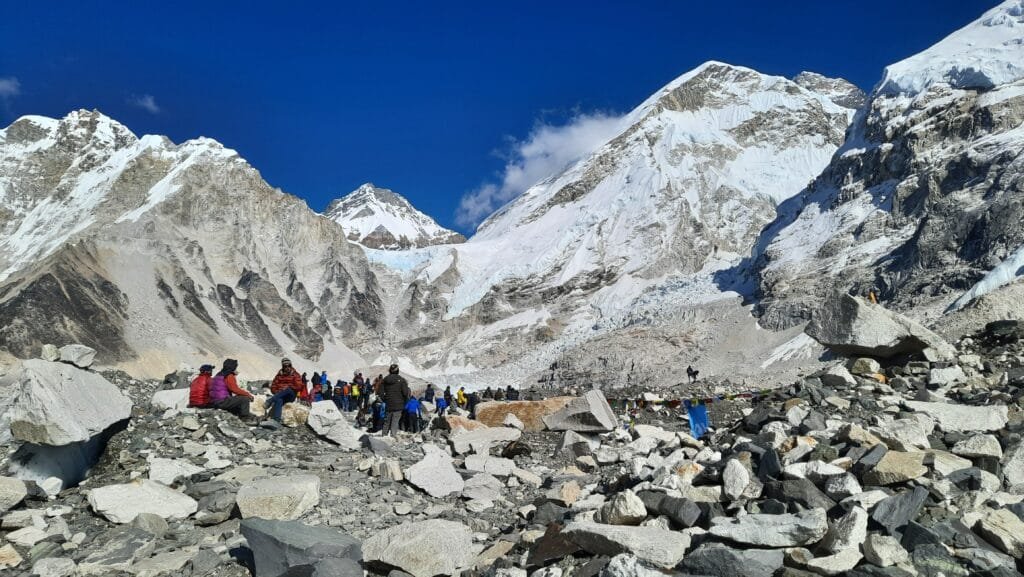
Standing at Everest Base Camp is an incredible and emotional moment. We take in the majestic scenery of Everest, Nuptse, Pumori, and the surrounding peaks, celebrate our achievement, and bask in the overwhelming sense of accomplishment. This is a moment that inspires and motivates, a testament to the human spirit's ability to conquer challenges and reach new heights.
Travel Sector: Gorak Shep-Kalapathar-Gorak Shep-Pangboche by Trek
Trek Distance: Approx 22-24 Kms 11-12 Hrs
Altitude: Gorak Shep (16900 ft.)- Kalapathar (18200 FT.) - Pangboche (13100 Ft.)
Accommodation: Tea House stay in Pangboche
Meals: Breakfast, Lunch and Dinner Only
Today's trek begins before dawn as we go to Kala Patthar (5,545 m), the trek's highest point, offering the most spectacular panoramic views of Everest and the surrounding Himalayan peaks. Leaving Gorak Shep (5,164 m) in the early morning darkness, we carry only a light daypack with essentials like water, snacks, extra layers, trekking poles, and a camera while leaving unnecessary gear at the teahouse. The trail begins with an easy walk over sandy fields before transitioning into a steep and demanding ascent for about 45 minutes. The terrain is rocky, and the thin air at high altitudes makes the climb challenging. After this strenuous stretch, the path flattens into level fields, allowing for a gradual and more comfortable walk for about an hour. The final steep push of 30 minutes over rugged terrain exposes us to harsh, cold winds. Still, as we gain elevation, the breathtaking views of Gorak Shep, Khumbu Glacier, Ama Dablam, and the surrounding peaks make the effort worthwhile.

Upon reaching Kala Patthar's summit, we are greeted by a spectacular 360-degree view of the Everest region. Mt. Everest (8,849 m), Nuptse (7,861 m), Pumori (7,161 m), Lhotse (8,516 m), and countless other peaks dominate the skyline. The golden hues of the sunrise reflecting off Everest's icy slopes create an unforgettable sight. At the summit, colorful prayer flags flutter in the wind, and a weather monitoring station symbolizes ongoing research in the region. We take ample time to soak in the views, capture photographs, and relish the moment, celebrating one of the most rewarding highlights of the trek.
After spending enough time at the summit, we descend back to Gorak Shep, following the same path. The descent takes about one hour, and as we lose altitude, the oxygen levels increase, making the journey easier. Back at Gorak Shep, we enjoy a well-earned breakfast at our teahouse before continuing our trek down towards Pangboche (3,985 m).
The descent follows a familiar route back through Lobuche (4,940 m). After a short rest in Lobuche, we continue along the Khumbu Glacier's moraine, witnessing its impressive icy formations and the towering peaks surrounding it. Soon, we reach Thukla Pass (4,830 m), home to the solemn Everest Memorial, a site dedicated to climbers who lost their lives attempting to summit Everest. The stone chortens here serve as a reminder of the mountain's formidable challenges and the resilience of those who dare to climb it.
From Thukla Pass, we begin a steep descent along the moraine wall before crossing the river below. Here, the trail splits into two—one leading towards Dingboche and the other towards Pheriche. We take the lower route through Pheriche (4,371 m), slightly more straightforward and sheltered from the wind. Pheriche is home to a medical aid post run by the Himalayan Rescue Association (HRA), where many trekkers stop for treatment in case of altitude-related issues. This small settlement is often bustling with trekkers, guides, and mountaineers on their way up and down the Everest trail.
After a brief stop in Pheriche, we continue our descent, passing through rocky trails, glacial streams, and vast open landscapes. As we lose altitude, the air becomes richer in oxygen, making the trek progressively more comfortable. Soon, we arrive in Pangboche (3,985 m), one of the Khumbu region's oldest and most culturally significant Sherpa villages.
Upon reaching Pangboche, we check into a cozy teahouse, where we can finally rest after a long and rewarding trek. The village is home to the famous Pangboche Monastery, one of the oldest Buddhist monasteries in the region. If time and energy permit, we can visit the monastery to learn about Sherpa culture, Buddhism, and the history of Everest expeditions. The village offers stunning views of Ama Dablam, which now looms closer than ever. A warm meal and a good night's rest prepare us for tomorrow's next leg of our descent towards Namche Bazaar.
Travel Sector: Pangboche - Namche Bazaar by Trek
Trek Distance: Approx 14 Kms 5-6 Hrs
Altitude: Pangboche (13100 Ft.)- Namche Bazaar (11300 Ft.)
Accommodation: Tea House stay in Namche Bazaar
Meals: Breakfast, Lunch and Dinner Only
After days of trekking through the high-altitude regions of Everest, today's journey brings a moderate descent from Pangboche to Namche Bazaar, marking one of the final trekking days of the journey. Though the trail primarily descends, there are a few short ascents along the way, making the trek both scenic and rewarding. As this is a long 14 km trek, we recommend starting early to ensure a comfortable and relaxed journey.
Leaving Pangboche, the trail descends through a beautiful forested landscape, offering stunning views of Ama Dablam, Everest, and Lhotse in the background. The first section of the trek takes us down to the river, where we cross a sturdy suspension bridge swaying above the fast-flowing waters of the Dudh Koshi River. From here, we begin a gradual ascent along the valley wall, a zig-zagging uphill climb of approximately 2 km. As we climb, the path transitions into a lush rhododendron and pine forest, providing shade and a peaceful atmosphere.
Upon reaching the top of the ascent, we briefly rest to catch our breath and admire the views before continuing. The trail then levels out, becoming a smooth and gradual path for the next 5 km. As we move forward, the familiar sight of the Dudh Koshi River below and the valley opening up ahead signals that we are nearing our destination. The well-trodden trail, carved into the valley wall, offers breathtaking views of the surrounding landscape. Eventually, as the path bends inward, we catch our first glimpse of Namche Bazaar, the bustling Sherpa town in the mountains.
The final section of today's trek involves a short descent into Namche Bazaar, where we check into our teahouse for a well-earned rest. Having completed the challenging portion of the Everest Base Camp trek, we can now relax, explore the town, and celebrate our journey. Namche Bazaar offers numerous souvenir shops, bakeries, and cafés, making it a great place to buy mementos, enjoy a warm beverage, and reflect on the incredible adventure we've experienced.
Travel Sector: Namche Bazaar-Phakding-Lukla by Trek
Trek Distance: Approx 16 Kms 7-8Hrs
Altitude: Namche Bazaar (11300 Ft.)-Phakding (8500 ft.) - Lukla (9350 Ft.)
Accommodation: Tea House stay in Lukla
Meals: Breakfast, Lunch and Dinner Only
Today marks the last day of trekking as we make our way from Namche Bazaar to Lukla via Phakding, covering a distance of 16 km over 7 to 8 hours. The journey consists of a continuous descent to Phakding followed by a gradual ascent to Lukla, bringing our incredible Everest Base Camp trek to a close. We recommend starting early in the morning, as the long descent can be demanding on the knees. It's also important to be mindful of altitude sickness, which can occur at high altitudes. A timely arrival at Lukla ensures a comfortable evening to celebrate the completion of the trek.
The day begins with a leisurely morning in Namche Bazaar, a vibrant hub of activity. This is our chance to explore the bustling market, buy souvenirs, or enjoy a warm beverage in local cafés. As the most significant trade hub in the Khumbu region, Namche offers a variety of handicraft stores where you can purchase authentic Tibetan and Sherpa artifacts, woolen clothing, and prayer flags as keepsakes from your journey. For those interested in nature and local culture, a short walk to Sagarmatha National Park offers a serene start to the day before we trek to Lukla.
As we bid farewell to Namche Bazaar, the trail leads us on a steep descent, a test of our agility and balance. The first 45 minutes of the trek demand careful footing, as the steep downward path can be challenging on the legs. Along the way, we arrive at a familiar rest stop, where we get our final glimpses of Mt. Everest before it disappears behind the hills and forests. From here, the landscape undergoes a dramatic transformation, transitioning from towering peaks to dense rhododendrons and pine forests. The trek continues past suspension bridges swaying over the Dudh Koshi River, offering breathtaking views of cascading waterfalls and small Sherpa villages in the valley below.
After several hours of gradual descent, we reach Phakding, a picturesque village along the riverbanks. This is the perfect spot to pause for lunch and rest, allowing trekkers to replenish their energy before the final stretch to Lukla. After lunch, the trail continues alongside the river, offering stunning views of mountain ridges, green valleys, and terraced fields. Though most of the trek is downhill, a few short ascents and stair sections require effort before reaching Lukla.
The final segment of the trek passes through small Sherpa villages, where trekkers can interact with locals and observe their traditional way of life. It's important to remember to respect their customs and privacy. After several hours of walking, Lukla finally comes into view, marking the end of this incredible trekking adventure. Upon arrival, we check into a teahouse and take time to relax, reflect, and celebrate the completion of the Everest Base Camp trek. Since this is the last night with the Sherpa guides and porters, it is common for trekkers to gather for a farewell dinner, sharing stories, enjoying delicious food, and perhaps raising a toast to an unforgettable journey.
Travel Sector: Lukla - Ramechhap - Kathmandu
Flight to Lukla-Ramechhap: 30-45 Minutes
Drive Ramechhap to Kathmandu: Approx 135 Kms 4-5 Hrs
Altitude: Lukla (9350 Ft.) - Kathmandu (4600 Ft.)
Accommodation: 3* Hotel in Kathmandu
Meals: Dinner Only
Transport: Ramechhap to Kathmandu Hotel
Today marks the end of your incredible Everest Base Camp adventure as you prepare to leave the breathtaking Himalayas and return to the lively city of Kathmandu. The day begins early, as flights from Lukla to Ramechhap are usually scheduled for the morning due to unpredictable weather conditions. Morning flights are generally more reliable, as afternoon flights often face delays due to strong winds and changing weather patterns. However, weather conditions in the mountains can be unpredictable, and flight cancellations or delays are possible at any time of the year, particularly during the summer and monsoon months. For this reason, keeping 3-4 buffer days is highly recommended in case of unexpected delays.
Once onboard, take one last look at the spectacular Himalayan peaks and lush valleys that have been your home for the past two weeks. The aerial views from the plane provide an unforgettable perspective of the rugged trails, towering mountains, and glacial landscapes you've traversed during your trek. It's a moment to reflect on the challenges you've overcome and the beauty you've witnessed throughout this adventure.
Upon arrival at Ramechhap Airport, a scenic drive back to Kathmandu awaits you. The journey by road offers a different experience of Nepal as you pass through charming villages, terraced farmlands, and winding hills. The drive takes approximately 4 to 5 hours, depending on traffic and road conditions. You'll witness the transition from rural Nepal to the bustling capital city, where the streets of Kathmandu welcome you back with their vibrant energy.
Once in Kathmandu, check into your comfortable hotel (included in the package) and take the rest of the day to relax and unwind. After days of trekking in remote high-altitude regions, you may enjoy a warm shower, a spa treatment, or a good meal in one of Kathmandu's many excellent restaurants.
For those with time and energy, the day can be spent exploring Kathmandu's rich cultural heritage at their own cost (not included in the package). You can visit iconic landmarks such as:
- Swayambhunath (Monkey Temple) – A stunning Buddhist stupa offering panoramic city views.
- Pashupatinath Temple – A sacred Hindu temple along the Bagmati River.
- Boudhanath Stupa – One of the largest Buddhist stupas in the world, perfect for an evening stroll.
- Thamel – A vibrant neighborhood filled with souvenir shops, cafés, and live music venues, perfect for celebrating your successful trek.
For those flying home, today is the perfect time to finalize travel arrangements and book onward flights. If you extend your stay in Nepal, you may embark on cultural tours, jungle safaris, or adventure activities before heading home. (You need to book this well in advance with The Travel Foot).
Today morning, own your own as per your flight schedule and make your departure accordingly.
Inclusion and Exclusions
The Cost Includes
- Hotel Accommodation: Day 1 & 13: Stay in a 3-star hotel in Kathmandu with Bed & Breakfast.
- Tea House Stay: Day 2 to Day 12: Accommodation in teahouses.
- Meals (Vegetarian): All meals from Lukla to Lukla, from Day 2 Lunch to Day 13 Breakfast.
- Fresh fruit is served after dinner daily.
- Versatile base camp manager for communication and emergency workforce deployment.
- Trek Leader – A mountaineering and first-aid certified professional.
- Experienced local guides (number depends on group size).
- Trekking Equipment:
- Gaiters & Microspikes (if required).
- First Aid & Safety Measures:
- Medical kit.
- Stretcher, oxygen cylinder, blood pressure monitor, oximeter, and stethoscope.
- Transportation (As per itinerary):
- Airport transfers upon arrival and departure. (on group pickup basis not individual)
- Domestic airport transfers for Lukla flights.
- Transfers between Kathmandu and Ramechhap/Lukla and back.
- A cloakroom facility at the base camp is used to store additional luggage.
- Permits & Entry Fees (For Indian nationals, per standard charges).
- Services covered from Kathmandu to Kathmandu.
- Farewell dinner in Kathmandu.
- Trek Completion Certificate.
The Cost Does Not Include
- Adventure Insurance (Mandatory), which costs approx INR 7000-7500
- Food during transit.
- Personal expenses.
- Mule or porter for carrying personal luggage.
- Emergency evacuation, hospitalization, or medical expenses.
- Anything not explicitly mentioned in the Inclusions.
- Additional Expenses:
- Personal porters (if required).
- WiFi, battery charging, and hot showers.
- Customary gratuities for guides & porters.
- Nepal Entry Visa (Approx. USD 40) – Required for foreigners (Not applicable to Indian nationals).
- Unforeseen expenses due to flight cancellations, weather conditions, etc.
- Extra night accommodation in Kathmandu.
Terms and Condition
Price Adjustments and Extra Charges
If there is a significant rise in transportation costs (including fuel surcharges), accommodations, or services provided by third parties (like local unions or government entities), the customer will be responsible for any additional expenses incurred.
Quoted prices are based on the current Indian tax framework. Any changes, new taxes, or tax increases imposed by authorities will lead to extra charges for which the customer is liable.
Itinerary Changes and Unexpected Events
The Travel Foot shall not be accountable for itinerary changes caused by natural disasters, landslides, flight, train, or bus cancellations and delays, adverse weather, or other unforeseen circumstances.
Any additional costs incurred in such situations will be the customer’s responsibility. During emergencies, such as natural disasters, our operational partners will provide assistance on the ground to ensure safety and address immediate needs. However, the expenses for such emergency actions will fall solely on the customer.
Please be aware that the trekking and driving times listed in the itinerary are approximate and may vary due to breaks for food and photos, road or weather conditions, or other unforeseen factors.
Risks and Liability
We will not be held responsible for outcomes resulting from natural disasters, severe weather conditions, airline delays or cancellations, strikes, theft, quarantine measures, civil unrest, government regulations, or other force majeure events.
The company is not liable for accidents or incidents involving vehicles or other modes of transportation during the scheduled program. Travelers acknowledge and accept the potential risks associated with travel and adventure activities. We will notify you promptly of any changes in circumstances, but any additional expenses due to such events will be the responsibility of the customer.
We also do not take responsibility for lost, stolen, or damaged personal belongings during the trip. It is recommended that travelers safeguard their belongings and consider obtaining travel insurance.
Booking and Cancellation Policy
By making a booking with us, you agree to and accept all terms and conditions outlined in this document. The company reserves the right to amend or cancel any trip based on prevailing conditions. Any additional expenses incurred from such changes will be the customer’s responsibility.
Insurance and Medical Responsibilities
All participants are strongly encouraged to purchase comprehensive travel insurance that covers trip cancellations, medical emergencies, and personal belongings. Travelers must disclose any medical conditions or limitations before booking. The company will not assume responsibility for any health-related issues during the trip.
General Information
While the company will strive to provide the best possible arrangements for all aspects of the trip, unforeseen challenges may still arise. Participation in the trip indicates acceptance of all the terms mentioned above, including any necessary last-minute changes for safety, operational, or logistical reasons.
Refer here for detailed T&C: https://thetravelfoot.com/terms-and-conditions/
Common Questions from Our Trekkers for Everest Base Camp Trek
The Everest Base Camp (EBC) Trek is a popular trekking route in Nepal that takes adventurers to the base camp of the world’s highest mountain, Mount Everest (8,848m). It offers stunning Himalayan scenery, Sherpa culture, and breathtaking landscapes.
The trek typically takes 12 to 14 days, including acclimatization days.
The best seasons are spring (March-May) and autumn (September-November) when the weather is stable, and the views are clear.
The trek is moderate to challenging, requiring a good level of fitness. There are long daily hikes at high altitudes, so physical and mental preparation is important
Prior trekking experience is helpful but not mandatory. Regular hikers or fit individuals can complete the trek with proper training.
Cardiovascular exercises (running, cycling), strength training (legs & core), and endurance hikes at least 3-6 months before the trek are recommended.
The highest point is Kala Patthar (5,545m), which offers panoramic views of Everest.
Acclimatization, a slow ascent, staying hydrated, avoiding alcohol, and listening to your body are key. Diamox (altitude sickness medication) may help.
Headache, nausea, dizziness, loss of appetite, and breathlessness. Severe cases can lead to High Altitude Pulmonary Edema (HAPE) or Cerebral Edema (HACE).
The trek starts with a flight from Kathmandu to Lukla and ends at the same point.
Tea houses (lodges) are available along the route, offering basic rooms and meals.
Meals include dal bhat (rice & lentils), noodles, pasta, momos, soups, and porridge. Tea houses offer vegetarian and some non-vegetarian options.
Yes, but it’s limited. Wi-Fi is available at tea houses for a fee. Ncell and Everest Link provide mobile networks in some areas
Helicopter evacuation is available in emergencies. Having travel insurance covering high-altitude trekking and evacuation is essential.

